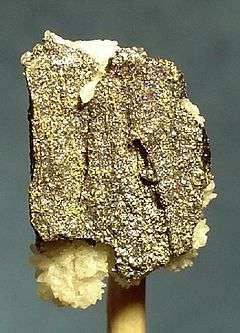Melonite
For the trademarked surface finish, see Ferritic nitrocarburizing.
| Melonite | |
|---|---|
|
Melonite after calaverite, on quartz. Cresson mine, Cripple Creek, Colorado. Size: 1.3 × 0.9 × 0.4 cm. | |
| General | |
| Category | Sulfide minerals |
| Formula (repeating unit) | NiTe2 |
| Strunz classification | 02.EA.20 |
| Dana classification | 02.12.14.01 |
| Crystal system | Trigonal |
| Unit cell | a = 3.84 Å, c = 5.26 Å |
| Identification | |
| Formula mass | 313.89 g |
| Color | White, reddish white |
| Crystal habit | Crystalline, foliated, granular |
| Cleavage | {0001} Perfect |
| Fracture | Brittle |
| Mohs scale hardness | 1–1.5 |
| Luster | Metallic |
| Streak | Dark gray |
| Diaphaneity | Opaque |
| Specific gravity | 7.72 |
| Density | 7.3 |
| Ultraviolet fluorescence | None |
| References | [1][2][3] |
Melonite is a telluride of nickel; it is a metallic mineral. Its chemical formula is NiTe2. It is opaque and white to reddish-white in color, oxidizing in air to a brown tarnish.
It was first described from the Melones and Stanislaus mine in Calaveras County, California in 1866, by Frederick Augustus Genth.
Melonite occurs as trigonal crystals, which cleave in a (0001) direction. It has a specific gravity of 7.72 and a hardness of 1–1.5 (very soft).
See also
References
- ↑ "Melonite Mineral Data". Webmineral.com. Retrieved 2011-10-28.
- ↑ "Melonite mineral information and data". Mindat.org. Retrieved 2011-10-28.
- ↑ "Mieralienatlas Lexikon - Melonit". Mieralienatlas. Retrieved 2011-10-28.
External links
-
 Media related to Melonite at Wikimedia Commons
Media related to Melonite at Wikimedia Commons
This article is issued from Wikipedia - version of the 6/26/2013. The text is available under the Creative Commons Attribution/Share Alike but additional terms may apply for the media files.
